› Forums › General Discussion › Following JWST through Orion to L2
- This topic has 63 replies, 14 voices, and was last updated 3 years, 10 months ago by
 Nick James.
Nick James.
-
AuthorPosts
-
28 December 2021 at 10:39 am #585048
 Nick JamesParticipant
Nick JamesParticipantDenis managed to get another image of the spacecraft last night at around mag 14.5. I’ve had no luck since the weather has been cloudy here and all of the iTelescope systems that I have tried to use have had “roof closed” even when the all-sky camera showed clear sky.
The Horizons ephemeris is good for the spacecraft. There has been quite a bit of amateur astrometry of the upper stage and you can get an ephemeris of that from Bill Gray’s artsat ephemeris page here.
30 December 2021 at 10:24 am #585050 Tim HaymesParticipant
Tim HaymesParticipantThe HB front cover of Constellations & How To Find Them (W. Peck) indicates the direction of JWST. Follow church spire up a bit and there it is. The only imaging i’ve done in 10 days !
Edit: Congratulations to Denis for some fine images on successive days, and good news (on 30th) that fuel reserves are greater than expected due to the excellent Ariane launch profile.
30 December 2021 at 11:12 am #585056 Tim HaymesParticipant
Tim HaymesParticipantI see on Denis’s images that JWST is about 3′ arc North of the HORIZONS position at my location in Oxfordshire. This is what my college maths gives me: (300/350,000) x 57.3 x 60 = 2.9′ ( Denis is 300 miles north of me). I don’t expect any prizes, but its good to exercise the brain cells from time to time.
30 December 2021 at 11:18 am #585057 David SwanParticipant
David SwanParticipantI acquired a set of frames last night: 2021-12-29T21:17:18 – 2021-12-29T21:25:46
Really pleased to get it, as the weather here (for astronomy, anyway) has been so poor.
30 December 2021 at 11:57 am #585058 Nick JamesParticipant
Nick JamesParticipantDavid – well done. Still no opportunities for me! It looks as if the complex deployment is going very well (https://blogs.nasa.gov/webb/).
30 December 2021 at 12:37 pm #585060 Grant PrivettParticipant
Grant PrivettParticipantSame in Wiltshire. Impressed by the Highlands having 4 clear nights in the last week when we cannot manage 1.
1 January 2022 at 8:36 am #585064 Nick JamesParticipant
Nick JamesParticipantI got images of the JWST spacecraft (2021-130A) and the Ariane upper stage (2021-130B) last night. They are currently around 2 degrees apart on the sky. JWST is much brighter tonight as the sunshield was being deployed. The magnitude was 14.3 at a range of 687,000 km. From the timings in the NASA blog I think that the sunshield was half out when this image was taken but this implies a magnitude of around 16 or so at L2. Astrometry of the upper stage is valuable since it is not being tracked by radio and I assume it is now passive.
1 January 2022 at 4:51 pm #585068 Grant PrivettParticipant
Grant PrivettParticipantNo clear night here in 2 weeks.
I think the blog now says the starboard boom is out and the tensioning of the sunshield will begin.
Your JWST mag report is very hopeful for getting images at L2.
What mag was the rocket body? Can I assume that won’t reach even a semi-stable orbit and will quickly drift away? Might be an interesting observation target for a while.
1 January 2022 at 10:43 pm #585069 Nick JamesParticipant
Nick JamesParticipantGrant, The upper stage was 16.5 last night. It will be passive now so optical astrometry is useful to determine where it is going. JWST will be injected into a halo orbit around L2 and will require periodic station keeping to keep it there. Since L2 is unstable the upper stage will move off into a heliocentric orbit with a period of around 380 days. Using astrometry from Peter Carson and myself I’ve integrated this forward and it is likely to return to the Earth’s vicinity in the summer of 2047 when it will be around mag 20 (see plot attached). The more accurately we can get astrometry as it departs the better we can predict where it will be in 2047 so surveys in 25 years time will know what it is.
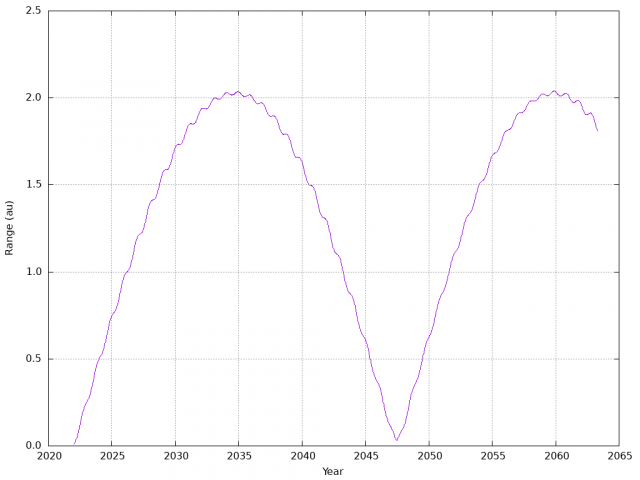 2 January 2022 at 12:00 am #585070
2 January 2022 at 12:00 am #585070 David SwanParticipant
David SwanParticipantNew Year report from Tynemouth: windy conditions, with clouds scudding across the sky. JWST is still within reach of moderate equipment: I am able to pick it up on individual 10 second frames taken through an 8 in RASA. Frame 5 start 21:35:26; frame 67 start 21:45:57. I have enough frames to make a reliable (I think) estimate of brightness – I’ll plate solve and find some suitable comparison stars.
2 January 2022 at 11:23 pm #585076 Nick JamesParticipant
Nick JamesParticipantNice image David. As of tonight (Jan 2) with the sunshield fully deployed but not yet tensioned JWST was mag 14.5 at a range of 800,000km. When it gets to L2 it will be twice as far away (1.5 million km) so probably around mag 16 although this will strongly depend on the solar aspect angle. That is 4-5 magnitudes brighter than Gaia.
The Ariane upper stage was magnitude 17.4 tonight at 890,000km. At this rate it will drop below mag 20 in early February when its range exceeds 2.5 million km.
3 January 2022 at 10:22 am #585078 Dave EagleParticipant
Dave EagleParticipantThanks to Nick posting details about this, I have managed to catch Webb on two nights so far:
http://www.star-gazing.co.uk/blog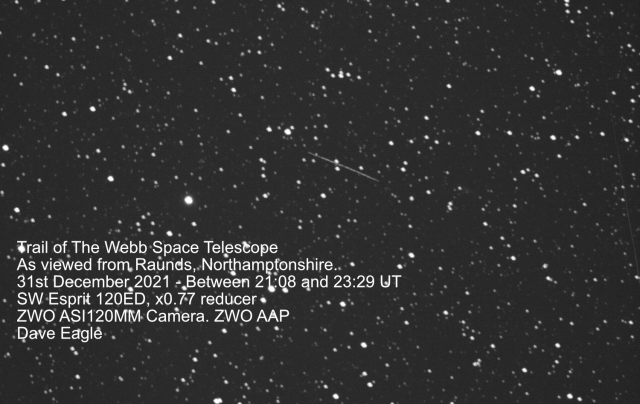
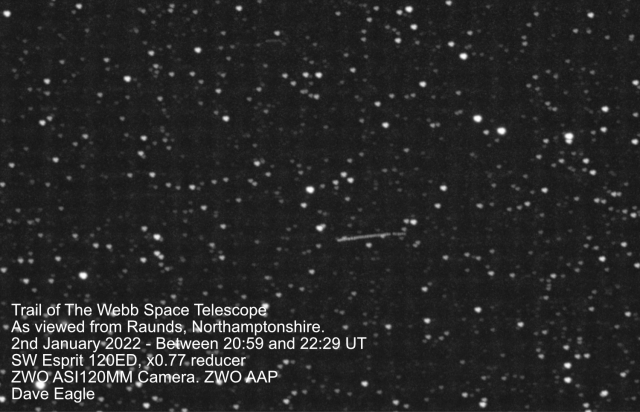 3 January 2022 at 11:58 am #585079
3 January 2022 at 11:58 am #585079 Dr Paul LeylandParticipant
Dr Paul LeylandParticipantI asked Jonathan McDowell about the value of tracking the Ariane for as long as possible.
He responded that it would be very useful to get as good an orbit as possible so that it can more easily be recovered when it returns to this neck of the woods in 2047.
The astrometry is being co-ordinated by Bill Gray at http://projectpluto.com and I urge anyone here, especially the asteroids people, to follow it as long as possible.
6 January 2022 at 12:27 am #585085 Mel GiggParticipant
Mel GiggParticipantI caught the JWST last night and made the video linked below, after reading on here that the Ariana upper stage was still visible I checked and I think I have that as well. Could someone confirm this please, it is brighter and slower than the JWST but definitely traveling in a similar orbit.
Thanks Mel
6 January 2022 at 7:57 am #585086 Nick JamesParticipant
Nick JamesParticipantHi Mel,
I’ve looked at your YT video and haven’t been able to ID the field yet and have to rush off to work now. I’ll have another look when I get in tonight. To help confirm that you have got JWST I attach an image I took just at the start of your set (Jan 4 at 22:29). The trail of JWST is marked. The upper stage is around 3 magnitudes fainter than JWST and around 2.5 degrees west of it so your other object is not the upper stage. I can probably identify it if you let me have an accurate position.
You can get an accurate ephemeris of both JWST and the upper stage from here:
https://projectpluto.com/sat_eph.htm
This is based on amateur astrometry of both objects and is pretty well up to date.
6 January 2022 at 2:24 pm #585087 Mel GiggParticipant
Mel GiggParticipantHi Nick
Thanks for your help, your image does agree with mine so JSWT confirmed. The second objects position at approximately the same time was RA 06h 30m 27s DEC +00° 50’ 05” as you can see from the video it’s travelling in exactly the same direction and line as the JWST but quite a bit slower.
Mel
6 January 2022 at 2:48 pm #585088 Mel GiggParticipant
Mel GiggParticipantHi Nick
Here‘s an image covering the object and JWST if it helps.
6 January 2022 at 3:49 pm #585089 Mel GiggParticipant
Mel GiggParticipantHi Nick
Just been checking myself and I think it’s an asteroid –
(787) Moskva is a 13th magnitude Asteroid appearing in the constellation Monoceros. It orbits the sun every 4.0 years at an average distance of 2.5 AU. It is a main belt asteroid which orbits the Sun between Mars and Jupiter.
(787) Moskva, a small asteroid, is roughly 27 kilometers across.
6 January 2022 at 9:07 pm #585091 Nick JamesParticipant
Nick JamesParticipantYes, it looks to be 787 (Moskva). Well done spotting it. As you’ve confirmed you got JWST as well.
7 January 2022 at 8:09 pm #585093 Philip MasdingParticipant
Philip MasdingParticipantI imaged JWST on 05/1/2022 for just over an hour and in that time its brightness seemed to vary quite a bit as seen in this stack:
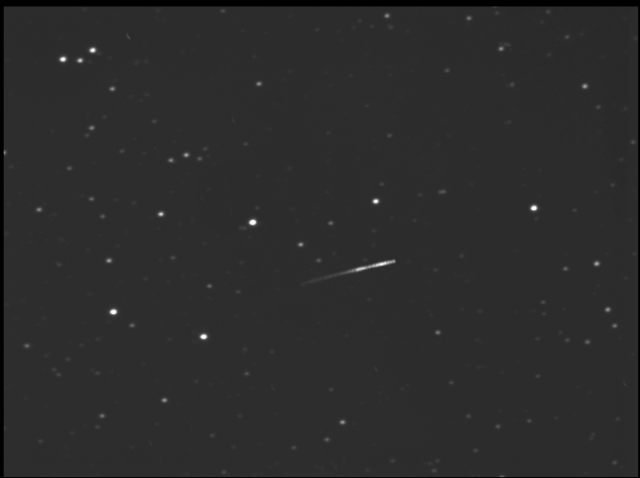
This graph shows the brightness of JWST over the period compared to 3 other field stars of similar brightness
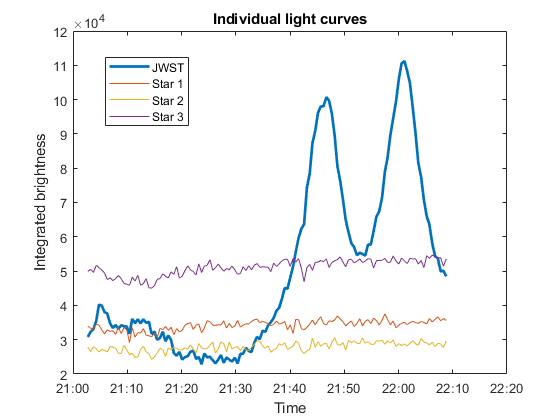
I was wondering what caused this variation because I assumed the spacecraft is not rotating and that the change in viewing angle over this time period would not be that great.
-
AuthorPosts
- You must be logged in to reply to this topic.
